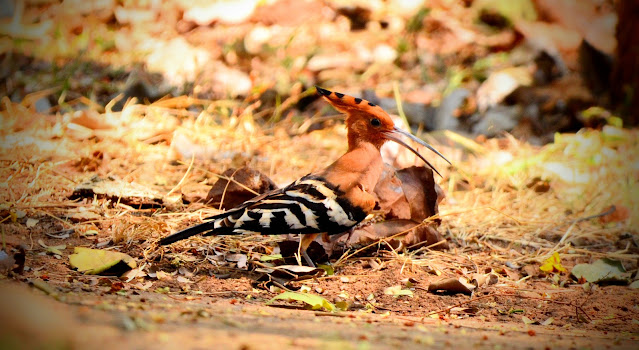JLR Kabini Back Waters - Part - 2
This is continued post from JLR Kabini Back Waters in earlier post I tired to post the details of wild animals which we spotted during our safari. In this post I will be adding the details of the birds which we spotted.
Along with different wild animals this forest gives nest for variety of birds.
We spotted following birds during our safari:
Indian Roller ನೀಲಕಂಠ - Its also state bird of our Karnataka ☺️
Indian Roller is also called Blue Jay. It is 13 inch long and is striking blue in colour. Indian Roller weighs around 80 -100 g. It's eyes and bill are black. It has a large head and short neck. Its crown, lower wings and tail are blue green in colour. The throat and upper breast are purple in colour.
The Madagascar hoopoe is a species of hoopoe in the family Upupidae. It was previously considered a subspecies of the hoopoe, but was split due to its vocalisations and small differences in plumage. Some taxonomists still consider all three species conspecific.
The Indian peafowl (Peakcock), also known as the common peafowl, and blue peafowl, is a peafowl species native to the Indian subcontinent.
Grey heron - The grey heron is a long-legged wading bird of the heron family, Ardeidae, native throughout temperate Europe and Asia and also parts of Africa. It is resident in much of its range, but some populations from the more northern parts migrate southwards in autumn.
Red-Naped Ibis - The red-naped ibis also known as the Indian black ibis or black ibis is a species of ibis found in the plains of the Indian Subcontinent. Unlike other ibises in the region it is not very dependent on water and is often found in dry fields a good distance away from water.
The Indian spot-billed duck - is a large dabbling duck that is a non-migratory breeding duck throughout freshwater wetlands in the Indian subcontinent.
The Jungle myna is a member of the starling family. It is found patchily distributed across much of the mainland of the Indian Subcontinent but absent in the arid zones of India
The red-wattled lapwing is an Asian lapwing or large plover, a wader in the family Charadriidae. Like other lapwings they are ground birds that are incapable of perching.
Crested serpent eagle - The crested serpent eagle is a medium-sized bird of prey that is found in forested habitats across tropical Asia. They fly over the forest canopy on broad wings and tail have wide white and black bars.
Grey Jungle fowl – The grey jungle fowl, also known as Sonnerat’s jungle fowl, is one of the wild ancestors of the domestic chicken together with the red jungle fowl and other jungle fowls.
The Malabar giant squirrel is a tree squirrel species that is large, fluffy, and colourful, with a head and body length of 25-50cm and a tail that is about the same or slightly greater in length. It weights between 1.5 and 2 kg. It inhabits tropical deciduous, semi-deciduous, and moist evergreen forests and woods.
Also got some beautiful pictures of the forest during our safari.
Things to remember:
- Best time to visit to spot wild animals is from March to May
- Camera charges will not be included in the safari. They will charge based on the lens which we use. I paid 1500 for 600MM lens + 270 Tax!
- Carry enough water
- Do not litter the place
Travel Tips
Distance from Bengaluru | – | 210 Kms |
Road Condition | – | Decent |
Nearest Town | – | H.D.Kote |
Fuel Station | – | H.D.Kote |
Near by places to visit | - | Irrpu falls, Bandipura |




















Comments
Post a Comment